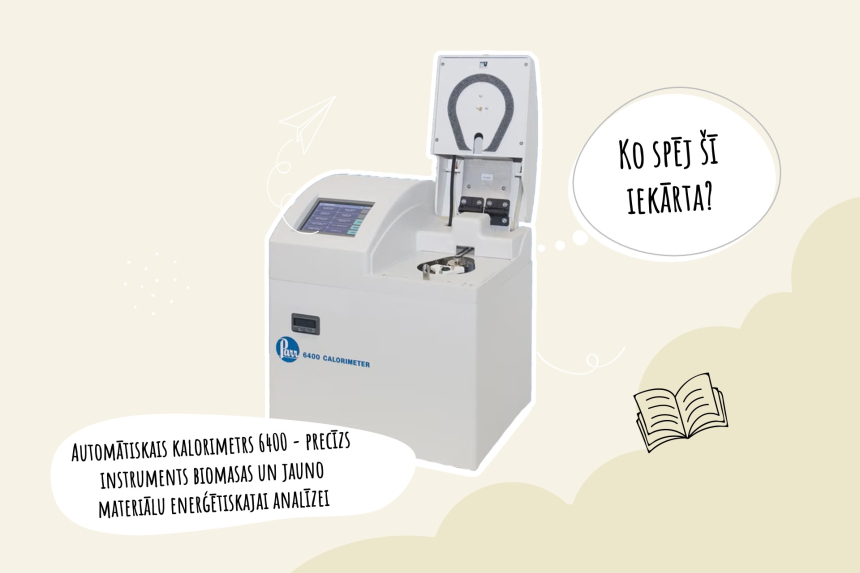What can this instrument do? Get to know the 6400 Automatic Isoperibol Calorimeter

This is the first article in the series “What can this instrument do?”, introducing the new laboratory equipment acquired within the WoodChemPlus project. Each publication will present one of these instruments – its main functions, applications, and the benefits it brings to science and industry.
The 6400 Automatic Isoperibol Calorimeter – a precision instrument for the energetic analysis of biomass and novel materials
Imagine an intelligent coffee machine that takes the cup itself, fills it with water, brews the drink, rinses, and prepares for the next serving — all at the press of a button.
That’s how automated the 6400 Automatic Isoperibol Calorimeter is. But instead of brewing coffee, it precisely measures how much heat and energy are released when a material is completely combusted.
The result is an “energy profile” – much like a barista’s flavor profile for coffee – precise, repeatable, and fully controlled.
As the first acquisition within the WoodChemPlus (Nr. 1.1.1.2/1/25/I/003) project, this instrument demonstrates the Latvian State Institute of Wood Chemistry’s (LSIWC) commitment to developing a modern, data-driven research infrastructure. It enables highly accurate determination of the energy potential of biomass and polymer-based materials, providing essential data for both scientific research and the development of advanced bio-based materials and fuels.
Installed as the first of nine new instruments acquired through WoodChemPlus, the Automatic Isoperibol Calorimeter is a high-precision system for determining combustion heat, sulfur, and chlorine content in several organic (biomass, polymers etc.) samples. It provides reliable data on the energetic potential of biomass and its processed products, supporting both scientific analysis and techno-economic evaluation. The instrument is equally valuable for companies developing bio-based raw materials, fuels, adhesives, coatings, and composite materials.
Why It Matters to Industry
The calorimeter performs fast and fully automated combustion test cycles, minimizing operator involvement. A single technician can operate up to four units simultaneously, significantly increasing laboratory throughput.
Its design is based on Parr’s Fixed Bomb and Bucket Technology, which enables a high degree of automation not only in data acquisition, but also in sample loading, rinsing, and cooling. This system ensures precise and repeatable results while extending the instrument’s lifetime, as combustion residues are automatically washed out immediately after each measurement.
Advantages for Industrial Testing
The 6400 Automatic Isoperibol Calorimeter is designed for environments where precision, reproducibility, and speed merge into a single rhythm. Each sample is automatically prepared, measured, and rinsed – the entire process takes about eight minutes, allowing researchers to proceed seamlessly to the next test. Every measurement is as accurate as the previous one, with a reproducibility margin of ±0.05 %, ensuring reliable data even for subtle variations in material properties.
The instrument operates in an isoperibol calorimetric mode with a closed water-circulation system and stable temperature control, maintaining consistent heat exchange throughout the test. Its calorimetric combustion vessel, made of niobium-stabilized stainless steel or halogen-resistant nickel alloy Hastelloy G30™, withstands even aggressive samples containing sulfur or chlorine – ensuring both long-term durability and measurement accuracy.
All processes are managed through specialized software that allows real-time monitoring of measurement stability and control charts, giving users a live view of each sample’s thermal behavior.
Practical Applications
The 6400 Automatic Isoperibol Calorimeter expands the research capabilities of LSIWC within the field of knowledge-intensive bioeconomy, enabling scientists to precisely assess the energetic potential of materials. It determines the combustion heat and energy value of biomass and polymer-based substances with exceptional accuracy, providing dependable data for evaluating their efficiency and comparability to fossil resources.
Each measurement reveals how much energy is stored in every fiber, droplet, or grain of powder, translating it into numerical data that guide strategic decisions for developing new materials and technologies. In collaboration with industry partners, the instrument serves as a bridge between laboratory research and production, ensuring that innovations are grounded in rigorous, scientifically validated data.
Its results are particularly valuable for energy and chemical industries, as well as for biomaterial producers seeking scientifically robust insights into the energetic and environmental performance of their products.